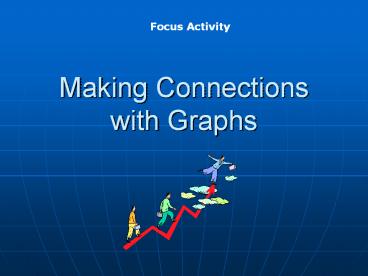Making Connections with Graphs - PowerPoint PPT Presentation
1 / 21
Title:
Making Connections with Graphs
Description:
Focus Activity Making Connections with Graphs Directions: Look at each graph Create a situation in which the value of one variable depends upon the other variable ... – PowerPoint PPT presentation
Number of Views:142
Avg rating:3.0/5.0
Title: Making Connections with Graphs
1
Making Connections with Graphs
Focus Activity
2
Directions
- Look at each graph
- Create a situation in which the value of one
variable depends upon the other variable - Your situation must fit the graph
3
What is the dependent variable? What is the
independent variable?
Joe walked the rest of the way to the park
He stopped to rest on a bench
Distance
Joe jogged to the park
TIME
4
How will our interpretation of the graph change
if our axes change?
of Customers
Hours worked
5
Interpret This Graph
Which pedal is the bus driver using when there is
a positive slope? A negative slope?
6
ActivityTwo-Way Interpretation
- Divide students into groups of 3
- Distribute Activity Sheets A D
- Students will interpret each graph two ways
- Students will discuss interpretations within
groups - Students will present their interpretations to
the class
7
Instruction
Making Connections with Graphs
8
A graph shows a relationship between two variables
- Graphs are used to describe real-life situations.
- Graphs demonstrate the relationship between two
variables.
9
This graph represents four people driving cars.
Which driver is driving at the fastest rate?
10
Identify the graph that best represents the
relationship between the number of gallons of
gasoline Mrs. Jones purchased and the cost of the
gasoline.
TAKS 2003
11
12
The graph represents the sales of a CD. Describe
the sales of the CD.
13
When you draw a graph without actual data, the
graph is called a sketch.Interpret this sketch.
Toms commute home
14
- Toms Commute Home
- Name your independent variable
- Name you dependent variable
15
The line touches the x axis three times. What
does this represent?
16
Remember!
- Rate of change is a term which describes the
SLOPE - Rate of change rise
- run
- Rate of change ? y or change in y
- ? x change in x
17
WHY?
- Why do you think slope is referred to as rate
of change?
18
Find the rate of change
19
Find the rate of change
20
Interpreting Graphs Steps
- Study the graph
- Identify the quantities that are being compared
- Look for trends Understand what relationship
the graph is describing - Look at the scales used on the axes of the graph
- Look for a pattern in the data increases,
decreases, or data that remain constant - Translate your observations into statements
- Example As distance increases, speed decreases
21
Any Questions?

